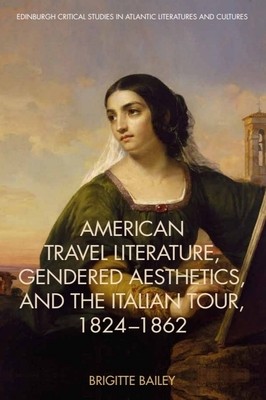
- We will send in 10–14 business days.
- Author: Brigitte Bailey
- Publisher: Edinburgh University Press
- ISBN-10: 1474432840
- ISBN-13: 9781474432849
- Format: 15.2 x 22.9 x 2.3 cm, softcover
- Language: English
- SAVE -10% with code: EXTRA
American Travel Literature, Gendered Aesthetics and the Italian Tour, 1824-62 (e-book) (used book) | bookbook.eu
Reviews
Description
Examines tourists' aesthetic responses in the context of US nation formation
American Travel Literature analyses tourist writings about Italy from 1824 to 1862 to explain what roles transatlantic travel, aesthetic response and the genre of tourist writing played in the formation of the United States. The Italian tour and its textual and visual expressions were forms through which predominantly white, northeastern elites dreamed their way into national identity and cultural authority. Its interdisciplinary methodology draws on antebellum visual culture, tourist practices and shifting class and gender identities to describe tourism and tourist writing as shapers of an elite (and then normative) national subjectivity. Bringing perspectives from art history and aesthetics, it historicises aesthetic practices, illuminating the depth of Americans' turn towards visual iconography in articulating social and national identities.
The book investigates tourists' triangulations of the categories of 'England', 'Italy' and 'America', discusses authors understood as national representatives - Irving, Cooper, Sedgwick, Kirkland, Fuller, Hawthorne and Stowe - in the context of other US and European writers and artists and looks at transatlantic tourist writing as a significant genre of the period that shaped the nation.
Key Features
- The interdisciplinary approach pushes analysis of growing area of travel writing further
- The trope of Italy as a woman reveals how gendered patterns of thought and response processed concepts of national identity thus recognising gender as a crucial mode of perception
- Historicizes aesthetic practices by looking closely at a particular genre (tourist writing) and its social functions in the antebellum period
EXTRA 10 % discount with code: EXTRA
The promotion ends in 4d.09:32:38
The discount code is valid when purchasing from 10 €. Discounts do not stack.
- Author: Brigitte Bailey
- Publisher: Edinburgh University Press
- ISBN-10: 1474432840
- ISBN-13: 9781474432849
- Format: 15.2 x 22.9 x 2.3 cm, softcover
- Language: English English
Examines tourists' aesthetic responses in the context of US nation formation
American Travel Literature analyses tourist writings about Italy from 1824 to 1862 to explain what roles transatlantic travel, aesthetic response and the genre of tourist writing played in the formation of the United States. The Italian tour and its textual and visual expressions were forms through which predominantly white, northeastern elites dreamed their way into national identity and cultural authority. Its interdisciplinary methodology draws on antebellum visual culture, tourist practices and shifting class and gender identities to describe tourism and tourist writing as shapers of an elite (and then normative) national subjectivity. Bringing perspectives from art history and aesthetics, it historicises aesthetic practices, illuminating the depth of Americans' turn towards visual iconography in articulating social and national identities.
The book investigates tourists' triangulations of the categories of 'England', 'Italy' and 'America', discusses authors understood as national representatives - Irving, Cooper, Sedgwick, Kirkland, Fuller, Hawthorne and Stowe - in the context of other US and European writers and artists and looks at transatlantic tourist writing as a significant genre of the period that shaped the nation.
Key Features
- The interdisciplinary approach pushes analysis of growing area of travel writing further
- The trope of Italy as a woman reveals how gendered patterns of thought and response processed concepts of national identity thus recognising gender as a crucial mode of perception
- Historicizes aesthetic practices by looking closely at a particular genre (tourist writing) and its social functions in the antebellum period


Reviews